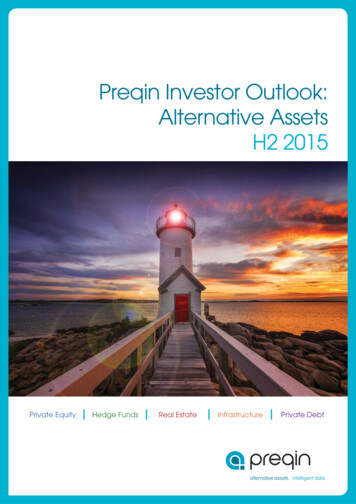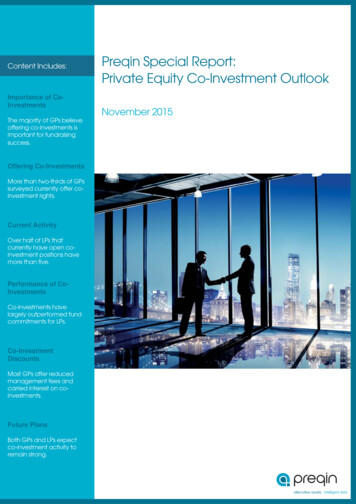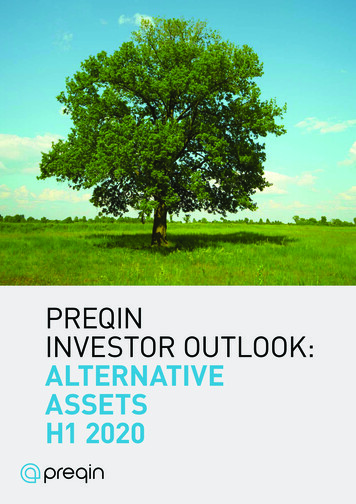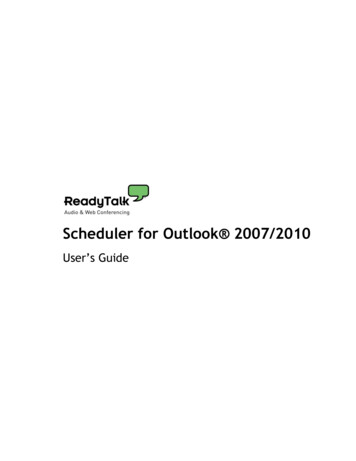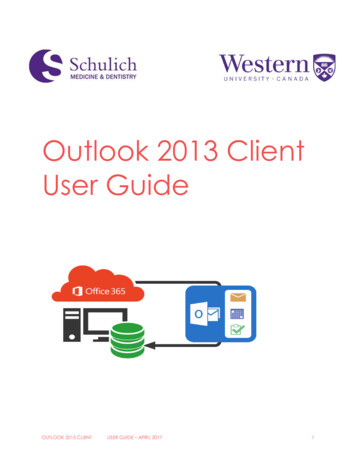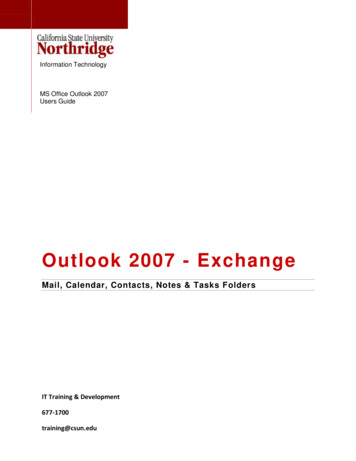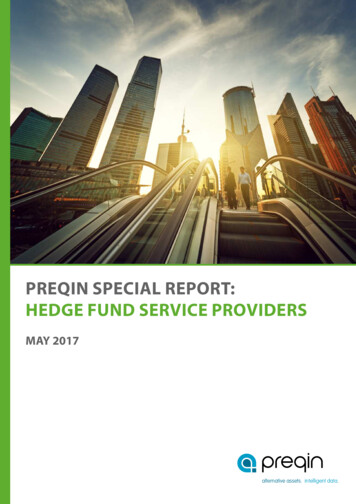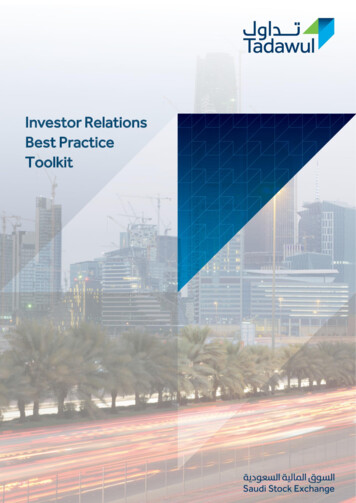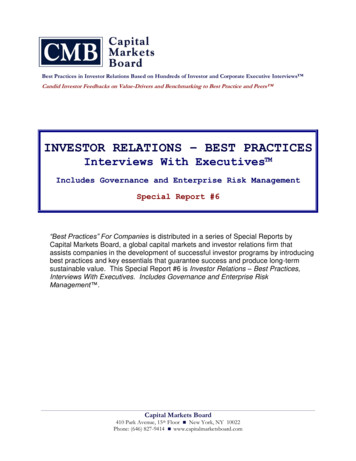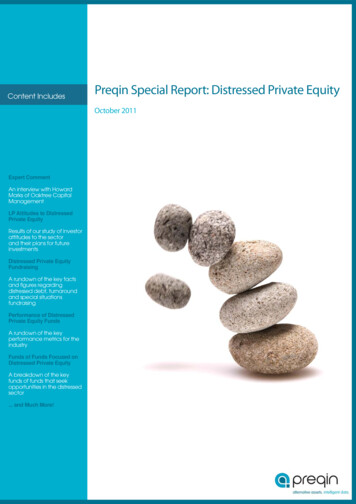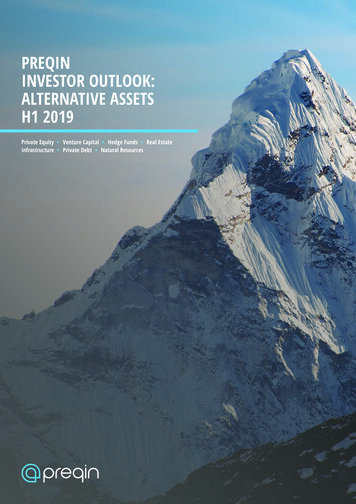
Transcription
PREQININVESTOR OUTLOOK:ALTERNATIVE ASSETSH1 2019Private EquityInfrastructure Venture Capital Hedge Funds Real EstatePrivate Debt Natural Resources
CONTENTSForeword21. ALTERNATIVE ASSETS5. INFRASTRUCTUREInfrastructure Delivers with Challenges Ahead27Infrastructure: Views on Performance28Participation in Alternative Assets4Infrastructure: Current Challenges29Reasons for Investing5Infrastructure: Plans for Next 12 Months30Equity Market Cycle6Investor Allocations72. PRIVATE EQUITYInvestors Confident in Private Equity9Private Equity: Views on Performance10Private Equity: Current Challenges11Private Equity: Plans for Next 12 Months123. HEDGE FUNDSInvestors Rebalance Their Hedge FundPortfolios15Hedge Funds: Views on Performance16Hedge Funds: Current Challenges17Hedge Funds: Plans for Next 12 Months186. PRIVATE DEBTAmple Opportunity for Private Debt Investors33Private Debt: Views on Performance34Private Debt: Current Challenges35Private Debt: Plans for Next 12 Months367. NATURAL RESOURCESInvestors Recognize Natural ResourcesBenefits39Natural Resources: Views on Performance40Natural Resources: Current Challenges41Natural Resources: Plans for Next 12 Months424. REAL ESTATEInvestors Committed to Real Estate inLong Term21Real Estate: Views on Performance22Real Estate: Current Challenges23Real Estate: Plans for Next 12 Months241
PREQIN INVESTOR OUTLOOK: ALTERNATIVE ASSETS, H1 2019FOREWORDEarly 2019 represents a pivotal point in time for the alternative assets industry. Having enjoyed a period ofsteady growth over the past decade, with total assets under management (AUM) at a record 9.44tn as ofJune 2018 (the latest data available), it is quite clear that this environment has begun to change.In November 2018, we conducted a survey of over 400 investors to understand their current views on each assetclass, the challenges they are facing and their plans for the next 12 months.With asset valuations currently at record levels, fund managers and investors we spoke to largely agree that weare at the peak of the equity market cycle and are due a correction. Towards the end of last year, however, publicmarkets were beginning to show signs of weakening. Alternative assets weathered the storm of the last recessionwell, though, and it is important to remember that investors allocate capital to alternatives for distinct reasons,beyond just sheer returns.In private equity, high absolute and risk-adjusted returns are the priorities for investors, whereas forinfrastructure and real estate they are seeking an inflation hedge and a reliable income stream. Investors inprivate debt are prioritizing high risk-adjusted returns and an income stream, and for hedge funds and naturalresources the primary motivations for investing are diversification and low correlation with other asset classes.Since alternatives clearly serve different purposes within an institutional portfolio, it is unsurprising that investorshave built larger and more complex portfolios over time – and there are few signs of this subsiding in the nearand longer term. Where an asset class had outperformed their expectations in recent years, most investors toldus they were looking to increase their allocations in 2019. Even for the asset classes that have demonstratedsub-par performance – namely natural resources and hedge funds – investors are still planning to increasetheir allocations in 2019. Hedge funds in particular have the ability to offer capital protection during a marketdownturn, and we expect to see investors rebalance their hedge fund portfolios in the coming year as theyposition more defensively.Although we expect the alternative assets industry to continue to grow, this will not be without challenges. Assetsare priced at record levels, competition for capital and deals is intense and fund managers are under exponentialpressure from investors to deliver in the current environment. Each individual asset class also has its own uniqueset of challenges, which we explore in more detail throughout this report.Encouragingly, the alternative assets industry as a whole has demonstrated the ability to adapt to, and overcome,these challenges. Fund managers are evolving their strategies and routes to market to continue to create value,investors are becoming increasingly sophisticated at evaluating the current opportunity set, and advisors arefrequently offering value-add services for their customers.A key ingredient in these selective strategies – for fund managers, investors and advisors alike – is goodinformation. We are honoured to be a partner and supplier for so many leading firms and professionals in theindustry, and we continue to invest heavily to expand and improve our data and services. Alternative assetsare our sole focus. We are grateful for your support, and we hope that you will find this report to be a helpfulresource and support for your work.2 Preqin Ltd. / www.preqin.com
The Home ofAlternativesIndispensable data, solutionsand insightsUnlock the potential of alternativesAccess the industry’s most comprehensive private market datasets and tools.Seamlessly build and manage your portfolioMaximize performance with solutions to reliably compile portfolio company data, efficiently valueinvestments and deliver effective, shareable investor reporting.Master your domainEnhance your point of view with publications, surveys and events that provide insider access to thelargest global network of alternative assets experts.Find out more: www.preqin.comSocial iconRounded squareOnly use blue and/or white.For more details check out ourBrand Guidelines.
PREQIN INVESTOR OUTLOOK: ALTERNATIVE ASSETS, H1 2019PARTICIPATION INALTERNATIVE ASSETSInstitutional Investors by Number of Alternative Asset Classes Invested urce: Preqin ProInstitutional Investors Allocating to Each Alternative Asset rce: Preqin ProInstitutional Investors by Target Allocation to Each Asset Class (As a % of Total Assets)PRIVATEEQUITYHEDGEFUNDS9.9%13.2%Average targetallocation5.5%Average targetallocation10.2%Average targetallocationLess than T6.3%Average targetallocationAverage targetallocation15-19.9%20% or MoreNATURALRESOURCES5.6%Average targetallocationSource: Preqin Pro4 Preqin Ltd. / www.preqin.com
1. ALTERNATIVE ASSETSREASONS FOR INVESTINGInstitutional Investors’ Main Reasons for Investing in Alternative AssetsDiversification80%70%60%Reduce Portfolio VolatilityHigh Risk-Adjusted Returns50%40%30%20%10%0%Reliable Income StreamHigh Absolute ReturnsLow Correlation to Other AssetClassesInflation HedgePrivate EquityHedge FundsReal EstateInfrastructurePrivate DebtNatural ResourcesSource: Preqin Investor Interviews, November 2018Institutional Investors’ Targeted Returns for Their Alternative Assets PortfoliosPRIVATE EQUITYHEDGE FUNDSREAL ESTATEINFRASTRUCTUREPRIVATE DEBTNATURAL on of RespondentsLess than 2%2-7%8-13%14-19%20% or MoreSource: Preqin Investor Interviews, November 20185
PREQIN INVESTOR OUTLOOK: ALTERNATIVE ASSETS, H1 2019EQUITY MARKET CYCLEInvestor Views on Where We Are in the Current Equity Market %5%Trough2%Source: Preqin Investor Interviews, November 2018Investor Views on How Their Outlook on theEquity Market Cycle is Impacting Their PrivateCapital InvestmentsInvestor Views on How Their Outlook on theEquity Market Cycle is Impacting the Positioningof Their Hedge Fund Portfolios64%40%Positioning More Defensively toProtect Assets as a Priority54%26%Positioning Has Not Changed10%6%Positioning More Aggressively toAccumulate Assets as a PriorityInvesting MoreCapitalNo ChangeInvesting LessCapitalSource: Preqin Investor Interviews, November 20186Source: Preqin Investor Interviews, November 2018 Preqin Ltd. / www.preqin.com
1. ALTERNATIVE ASSETSINVESTOR ALLOCATIONSInvestors’ Expected Capital Commitments to Alternative Assets in the Next 12 Months Compared with thePrevious 12 MonthsPRIVATEEQUITYHEDGE FUNDSREAL ESTATE26%23%31%53%57%PRIVATE DEBT35%32%52%52%55%12%16%17%58%21%19%12%Less CapitalNATURALRESOURCESINFRASTRUCTURESame Amount of Capital29%More CapitalSource: Preqin Investor Interviews, November 2018Investors’ Intentions for Their Alternative Assets Allocations over the Longer TermDecrease AllocationMaintain Allocation49% 50%Increase Allocation59%54%44% 47%50%46%36%29%21%9%5%48%29%12%6%Private Equity5%Hedge FundsReal EstateInfrastructurePrivate DebtNatural ResourcesSource: Preqin Investor Interviews, November 20187
Preqin GlobalAlternativesReportsThe definitive guides to privatecapital and hedge fund marketsIn-depth review of 2018Find comprehensive reviews of market performance, fundraising and deal activity over the year, ingranular detail.Expert predictions for 2019Subject-matter experts from around the industry deliver key forecasts and discuss geopolitical anddisruptive trends for the year ahead.Navigate the cycleAn exclusive look at where institutional investors and alternative assets fund managers will puttheir money, their views on cyclical trends and performance, and their long-term plans. All takenfrom the results of the largest survey of alternative assets decision-makers you’ll find anywhere.Get the full reports at ocial iconRounded squareOnly use blue and/or white.For more details check out ourBrand Guidelines.@preqin
2. PRIVATE EQUITYINVESTORS CONFIDENT INPRIVATE EQUITYPrivate equity is clearly delivering forinstitutional investors, providing strongreturns that are meeting and oftenexceeding expectations.The prospects for the industry as we move through2019 and beyond are still positive, but there arelikely to be bumps along the way. Net cash flowwas negative in 2017 and, although still strong,fundraising slowed during 2018 in comparison to theInvestors are, however, confident that private equitywill continue to meet their portfolio objectives infuture, with many looking to place more capital inthe asset class over both the next 12 months andlonger term. How long this continues, though, willlikely be dependent on fund managers’ ability to notonly put capital to work in the current climate butalso to source suitable exit opportunities to continueto deliver to investors.record levels of 2017 as investors reduced the paceof new commitments. Pricing is at a record level andthe majority of investors feel that this will be the keythreat to return generation in the next 12 months.Key Survey Findings:65%of private equity investors targetannualized absolute returns of 12%or more.39%of private equity investors believe amarket correction will occur within thenext 12 months.72%of private equity investors believe assetvaluations will be a key challenge forreturn generation in 2019, the largestproportion across all asset classes.54%of private equity investors feel small tomid-market buyout funds present thebest opportunities in the current climate.61%of alternative assets investors believe weare at the peak of the equity market cycle.95%of private equity investors plan toincrease or maintain their allocation tothe asset class in the longer term.9
PREQIN INVESTOR OUTLOOK: ALTERNATIVE ASSETS, H1 2019PRIVATE EQUITY: VIEWS ONPERFORMANCEHigh absolute returns are one of the primaryreasons why investors allocate to the assetclass, as cited by more than half (51%) ofprivate equity investors surveyed towardsthe end of 2018, a much larger proportionwhen compared to other alternative asset classes.As such, private equity investors also generally seekhigher returns: almost two-thirds (65%) of investorstarget annualized absolute returns from their privateequity investments of 12% or more.The good news is that investors are largely satisfiedwith how their investments in the asset class haveperformed over the past year: 64% of investors feltperformance had met their expectations, while morethan a quarter (26%) said returns had exceededexpectations (Fig. 2.1). Across vintages 2011-2015,buyout funds have delivered a median net IRR of16-21%, followed by venture capital (13-21%) andgrowth (10-18%) funds.Fig. 2.1: Extent to Which Investors Feel TheirPrivate Equity Investments Have Lived up toExpectations over the Past 12 Months, 2012 - ov-18Fallen Short of ExpectationsExceeded ExpectationsMet ExpectationsSource: Preqin Investor Interviews, November 2012 - 2018said the returns from their portfolios in 2018 didnot meet expectations, up from 5% in 2017 and thelargest proportion since December 2013 (11%).As concerns over high valuations and the abilityof fund managers to successfully exit investmentsare potentially played out, however, the next 12months may tell a different story: around a thirdof investors feel their private equity portfolios willperform worse than they did in 2018, up from 20%at the end of 2017 (Fig. 2.2). This reduced confidenceis unsurprising considering that 10% of investorsAlthough many are wary that future returns may beeroded, investors are still confident that the assetclass can meet their portfolio objectives over thecoming year: 68% are just as confident that privateequity will deliver in 2019 as they were in 2018, while15% have more confidence in the asset class (Fig.2.3).Fig. 2.2: Investor Expectations for thePerformance of Their Private Equity Portfolios inthe Next 12 Months Compared with the Past 12Months, 2017 vs. 2018Fig. 2.3: Investors’ Change in Confidence in theAbility of Private Equity to Perform PortfolioObjectives over the Past 12 Months65%15%17%53%Nov-1730%Will PerformWorse15% 17%Will PerformAbout the SameWill PerformBetterSource: Preqin Investor Interviews, November 2017 - 201810No e68%Source: Preqin Investor Interviews, November 2018 Preqin Ltd. / www.preqin.com
2. PRIVATE EQUITYPRIVATE EQUITY:CURRENT CHALLENGESAs has been the case for the past few years,asset valuations will be the key challenge forreturn generation within the private equityindustry in 2019, as cited by almost threequarters (72%) of investors (Fig. 2.4) – this isby far the largest proportion across all asset classes.A significant 60% of investors believe pricingincreased further throughout 2018 (Fig. 2.5), but forhow long can it continue? Among all alternativesinvestors, 61% believe we are at the peak of theequity market cycle (Fig. 2.6). Thirty-eight percentof private equity investors believe that a marketcorrection will occur within the next year, but 22%think it is still more than 12 months away (Fig. 2.7).Fig. 2.5: Private Equity Investor Views on PortfolioCompany/Asset Pricing Compared with 12 MonthsAgoFig. 2.4: Private Equity Investor Views on KeyChallenges for Return Generation in 2019Asset Valuations72%Competition for Assets33%Exit Environment32%Stock Market Volatility28%23%Geopolitical Landscape20%Deal Flow2%17%RegulationCurrency Market Volatility60%40%Rising Interest RatesCommodity Market VolatilityAside from valuations, 32% of investors cite theability of fund managers to successfully exitinvestments as a key challenge for return generationin the year ahead. Exit figures generally reflectthis sentiment, as the aggregate value of privateequity-backed buyout exits has been on a generaldownward trend since 2014, and the ratio of dealto exit value has been rising in recent years. Thatbeing said, the picture is still positive for the exitenvironment: the aggregate value of buyout exitswas higher in 2018 ( 326bn) than in 2017 ( 297bn),and the total number of exits has remainedconsistently high in the past five years at close to orabove 2,000.10%7%5%Higher1%SameSource: Preqin Investor Interviews, November 2018Fig. 2.6: Alternative Assets Investor Views onWhere We Are in the Current Equity Market CycleLowerUnsureSource: Preqin Investor Interviews, November 2018Fig. 2.7: Private Equity Investor Views on PortfolioCompany/Asset PricingPeak61%Unsure12% 1% %Source: Preqin Investor Interviews, November 201822%Undervalued, ConsiderableRoom for Further Price RisesUndervalued, Some Roomfor Further Price RisesFairly ValuedOvervalued, Correction Morethan 12 Months AwayOvervalued, Correction Likelywithin Next 12 MonthsOvervalued, CorrectionImminentSource: Preqin Investor Interviews, November 201811
PREQIN INVESTOR OUTLOOK: ALTERNATIVE ASSETS, H1 2019PRIVATE EQUITY: PLANS FORNEXT 12 MONTHSPROCEEDING WITH CAUTIONBetween 2011 and 2016 investors were riding aliquidity wave as a result of positive net cash flowsfrom their private equity portfolios, which in turndrove fundraising and global AUM to record levels. At 432bn, 2018 fundraising levels were still strong, justdown on the 2017 high of 566bn, but the cash flowcycle appears to have reversed in 2017 with morecapital being called up by fund managers ( 500bn)than returned ( 495bn).As our survey illustrates, investors remain committedto private equity and the outlook for 2019 ispositive. Investors expect to be highly active in theasset class going forwards: almost a third (31%)are planning to commit more capital than they didin 2018 and a further 57% are planning to commitroughly the same amount (Fig. 2.8). That being said,this reduction in LP liquidity combined with widereconomic concerns and the potential for a marketcorrection is likely to see investors proceed withcaution. Investors will also be keen to avoid anyrepeat of the GFC and will likely be monitoring theirprivate equity allocations, and their wider portfolio,for any potential overallocation arising from adenominator effect.INVESTORS TARGET RE-UPSFig. 2.8: Investors’ Expected Capital Commitmentsto Private Equity Funds in the Next 12 MonthsCompared to the Previous 12 Months, 2015 - 7Nov-18Same Amount of CapitalMore CapitalLess Capital57%12%Source: Preqin Investor Interviews, November 2015 - 2018a mix of re-ups and new relationships with GPs withwhich they have not previously worked (Fig. 2.11). Athird of surveyed investors are planning to committo the asset class predominantly or solely via re-ups,which is unsurprising given the backdrop of capitalconsolidation in the industry – also concerned abouta potential economic downturn, many investors areconsolidating their private equity programs.THE BEST OPPORTUNITIESThe largest proportion (45%) of surveyed investorswill be looking to make their new commitments viaIn line with previous years, the largest proportion(54%) of investors feel small to mid-market buyoutfunds are presenting attractive opportunities in theFig. 2.9: Number of Private Equity Funds InvestorsPlan to Commit to in the Next 12 MonthsFig. 2.10: Timeframe for Investors’ Next IntendedCommitment to a Private Equity Fund35%31%Q1 201922%12%Q2 2019H2 20191 Fund2-3 Funds4-9 Funds10 Funds orMoreSource: Preqin Investor Interviews, November 20181260%2020 or Later18%13%8%Source: Preqin Investor Interviews, November 2018 Preqin Ltd. / www.preqin.com
2. PRIVATE EQUITYcurrent market (Fig. 2.12). Large to mega buyoutfunds, however, have slipped somewhat out offavour with investors over the past year: 18% believethis fund type presents favourable opportunities,down from 21% in December 2017. Growth fundshave seen rising investor interest in recent years,and 29% of investors feel they present the bestopportunities in the current environment.capital to emerging markets (Fig. 2.13). Only a smallproportion (8%) of investors will commit the majorityof their capital to emerging markets in the yearahead.Over the course of 2019, 36% of surveyed investorsWithin developed markets, two-thirds of investorsbelieve that the US presents the most attractiveinvestment opportunities, followed by WesternEurope (excluding the UK, 49%, Fig. 2.14). The UKspecifically is viewed favourably by 28%; however,the market uncertainty arising from Brexit couldwill exclusively target investment in developedmarkets, while 40% will focus predominantly ondeveloped markets but may also allocate somedeter investors, with one investor explaining theywould not look to the UK until after Brexit. Certainmarkets within developed Asia are attractingFig. 2.11: Private Equity Investors’ Intentions forForming New GP Relationships over the Next 12MonthsFig. 2.12: Investor Views on Fund Types Presentingthe Best Opportunities in Private Equity21%Mix of New Relationshipsand Re-upsMainly Re-ups, Some NewRelationships45%Only Re-upsSource: Preqin Investor Interviews, November 201840%49%Mainly Developed Markets,Some Emerging Markets28%Mix of Developed andEmerging MarketsMainly Emerging Markets,Some Developed MarketsOnly Emerging MarketsSource: Preqin Investor Interviews, November 2018Western Europe(Excl. UK)36%67%US16%Fig. 2.14: Investor Views on Developed MarketsPresenting the Best Opportunities in Private Equity21%NordicOnly Developed Markets3% 5%16%Source: Preqin Investor Interviews, November 2018UKFig. 2.13: Private Equity Investors’ Intentions forTargeted Markets in the Next 12 Months3%11%10%7%6%5%SingaporeMainly New Relationships,Some Re-ups14%Australia & NewZealand7%54%29%23%18%14%13%11%9%8%South Korea13%Buyout – Small to Mid-MarketGrowthSecondariesBuyout – Large to MegaVenture Capital – Early StageVenture Capital – GeneralVenture Capital – Late StageVenture Capital – SeedFund of FundsVenture Capital – Venture DebtOtherCanadaOnly New RelationshipsJapanBREXIT A POTENTIAL DETERRENTSource: Preqin Investor Interviews, November 20113
PREQIN INVESTOR OUTLOOK: ALTERNATIVE ASSETS, H1 2019OUTLOOK FOR 201927%22%Other LatinAmerica6%2%Russia7%Middle East13%Africa14%BrazilPooled, single-manager funds will remain thestructure of choice for private equity investorsin 2019, with almost three-quarters of investorsplanning to commit capital to the asset class via thismethod (Fig. 2.16). A notable 35% of investors plan toco-invest alongside fund managers in the near futureas they look to take advantage of opportunities formore favourable fees and greater control.30%Other EmergingAsiaCentral &Eastern EuropeCO-INVESTING UPTAKE49%IndiaWithin emerging markets, Asia is viewed mostfavourably (Fig. 2.15). Almost half (49%) ofrespondents named China specifically, while 30%cited India. Twenty-seven percent of investors feelother regions within Emerging Asia are presentingattractive opportunities.Fig. 2.15: Investor Views on Emerging MarketsPresenting the Best Opportunities in Private EquityChinainterest: 11% of investors view Japan favourably,followed by South Korea (7%) and Singapore (5%).Source: Preqin Investor Interviews, November 2018the asset class has delivered, as well as the otherbenefits on offer. Almost all surveyed investors areplanning to maintain or increase their allocation toprivate equity over the longer term, which is a similarlevel to previous years (Fig. 2.17).Despite investors’ concerns over the performanceof the asset class amid rising valuations, theyremain committed to private equity as they seek totake advantage of the strong risk-adjusted returnsFig. 2.16: Structures that Investors Expect toUtilize for Their Private Equity Investments inFutureFig. 2.17: Investors’ Intentions for Their PrivateEquity Allocations over the Longer Term,2012 - 201874%33%17%Separate Accounts21%Direct Investments27%Pooled Fundsof FundsCo-InvestmentsPooled SingleManager Funds35%Source: Preqin Investor Interviews, November Decrease AllocationMaintain Allocation49%Increase AllocationSource: Preqin Investor Interviews, November 2012 - 2018 Preqin Ltd. / www.preqin.com
3. HEDGE FUNDSINVESTORS REBALANCE THEIRHEDGE FUND PORTFOLIOS2018 was a challenging year for hedge funds: adifficult Q4 for performance, coupled with a net 34bn being withdrawn from hedge funds, resultedin AUM dropping over the last six months of theyear to 3.45tn as at December 2018. However, theindustry is still 3x the size it was a decade ago, asinvestors recognize the ability of hedge funds to actas a portfolio diversifier and risk mitigator.to build up portfolios has slowed as many investorshave reached their desired level of exposure. Ourresults reveal that four out of five investors plan tomaintain or increase their exposure to hedge fundsin 2019. We also expect investors to redeem andrebalance in favour of less correlated strategiesto ensure capital is protected in the event of adownturn.Following the Global Financial Crisis (GFC), faced withThe outlook for 2019 is therefore nuanced. Whilethe prospect of not meeting long-term liabilities,many institutional investors turned to hedge fundsand capital flowed into the asset class. Over thesecond half of this decade, however, capital enteringthe asset class has slowed and there are signsindustry AUM may have begun to plateau. The rushthe slowdown in growth may indicate a lack ofactivity, beneath the surface we expect high levelsof movement of capital. Whether hedge funds candeliver this for investors will be crucial in 2019, andmanagers must recognize the specific needs of eachinvestor and be able to adapt to them.Key Survey Findings:55%of hedge fund investors weredisappointed with the performance oftheir portfolios in 2018.79%of hedge fund investors plan to increaseor maintain their allocation to hedgefunds over the longer term, the largestproportion since December 2013.42%of hedge fund investors believe stockmarket volatility is the biggest threat toreturn generation in 2019.40%of hedge fund investors are planning toposition their portfolios more defensivelyin the year ahead.61%of alternative assets investors believe weare at the peak of the equity market cycle.29%of hedge fund investors are lookingto increase their exposure to macrostrategies over the next 12 months.15
PREQIN INVESTOR OUTLOOK: ALTERNATIVE ASSETS, H1 2019HEDGE FUNDS: VIEWS ONPERFORMANCEBack at the end of 2017, investor satisfactionwith the performance of hedge funds wasat its highest level since the end of 2013;following 12 consecutive months of positivereturns, the Preqin All-Strategies HedgeFund benchmark ended the year on 11.99%. Fastforward one year, however, and investor sentimenthas changed following a turbulent year for bothhedge funds and the wider global economy. Hedgefunds lost 3.41% over 2018, and more than half (55%)of surveyed investors told us the performance of theasset class fell short of their expectations (Fig. 3.1).However, high absolute returns are not the primarymotivation for investing in hedge funds for themajority of investors, and many look to hedge fundsto provide downside protection in times of marketvolatility. While returns were down, the losses werenot as severe as those seen in equity markets, andthe volatility of hedge funds (4.28%) was much lowerthan that of the S&P 500 PR Index (15.30%). Withthis in mind, over half (57%) of investors remainconfident in the ability of hedge funds to meet theirportfolio objectives; over the past year, 16% ofinvestors have become more confident in the assetclass (Fig. 3.2), up slightly from 14% that said thesame at the end of 2017.Fig. 3.2: Investors’ Change in Confidence in theAbility of Hedge Funds to Perform PortfolioObjectives over the Past 12 MonthsFig. 3.1: Extent to Which Investors Feel TheirHedge Fund Investments Have Lived up toExpectations over the Past 12 Months, 2013 - 3%66%16%Nov-13Fallen Short of ExpectationsExceeded Expectations8%55%29%Nov-16Nov-17Nov-18Met ExpectationsSource: Preqin Investor Interviews, November 2013 - 2018Looking ahead, 37% of investors believe theperformance of their hedge fund portfolios willimprove over the course of 2019, while only 17%think performance will be worse than in 2018 (Fig.3.3).Fig. 3.3: Investor Expectations for thePerformance of Their Hedge Fund Portfolios inthe Next 12 Months Compared with the Past 12Months, 2017 vs. 201846%27%40%16%Increased Confidence32%28%37%No ChangeReduced ConfidenceNov-17Nov-1817%57%Will PerformWorseSource: Preqin Investor Interviews, November 201816Will PerformAbout the SameWill PerformBetterSource: Preqin Investor Interviews, November 2017 - 2018 Preqin Ltd. / www.preqin.com
3. HEDGE FUNDSHEDGE FUNDS: CURRENTCHALLENGESInvestor sentiment is turning increasinglybearish towards equity markets; the volatilitythat bookended 2018 is at the forefront ofinstitutional concerns. The largest proportion(42%) of investors believe that equity marketvolatility will continue into 2019 and will be a keychallenge to hedge funds’ capabilities in generatingreturns (Fig. 3.4).markets as a hindrance to performance in recentyears.This very volatility may prove to be the wind in thesails of many hedge fund strategies, though, manyof which are designed to thrive in times of marketturbulence. Numerous hedge fund managers haveblamed the extended growth and calm acrossA growing pool of investors think we are at the top ofthe equity cycle and, with this in mind, are looking toposition their hedge fund portfolios more defensivelyin the event of a market crisis or correction (Fig.3.5). Although hedge funds as a whole were caughtout by the volatility at the end of 2018, many havereduced their long-only exposure in recent monthsand other strategies show negative or no correlationto market direction. As a result, we may see investorsrebalance portfolios in favour of hedge funds in2019, especially less correlated strategies.Fig. 3.4: Hedge Fund Investor Views on the KeyChallenges for Return Generation in 2019Fig. 3.5: How Hedge Fund Investors Intend toPosition Their Portfolios in Response to the EquityMarket CycleStock Market Volatility54%42%Rising Interest Rates35%Geopolitical Landscape40%34%As
Institutional Investors by Target Allocation to Each Asset Class (As a % of Total Assets) Less than 5% 5-9.9% 10-14.9% 15-19.9% 20% or More Source: Preqin Pro Source: Preqin Pro . An exclusive look at where institutional investors and alternative assets fund managers will put their money, their views on cyclical trends and performance, and .
